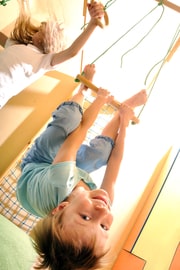Looking For a Family Dog? 8 Best Dog Breeds For Kids
As a parent, I have had the joy of raising my own children with dogs. We have raised several breeds of dogs over the years, but one thing is for sure – no matter what breed you raise or adopt, your life will be better for it. The unconditional love that our family pets show us is beyond amazing!
Kids are drawn to animals and vice versa, so consider adding some furry friends to your family’s dynamic if you are looking for ways to enhance your child’s development and overall well-being.
Experts say: “Protecting kids from pets is probably one of the worst things we can do as parents. Petting a dog lowers your blood pressure and reduces stress, while the unconditional love you get from a pet can be an excellent way to teach your children about trust.”
In fact, it’s been scientifically proven that “pets have been shown to reduce blood pressure as well as other serious health conditions such as heart failure, depression and asthma. In addition, pets provide psychological benefits such as increased self-esteem, elevated social interactions and reduced risk for loneliness – all factors that contribute to better overall health”.
Family Friendly Dogs
Here are 8 of the best breeds for children:
1) Golden Retrievers
Goldens have a “soft mouth,” meaning they can carry an egg in their mouths without breaking it. As such, kids love to climb all over them and pull on their fur. They are patient, kind, loving dogs that get along well with everyone (humans and other animals included). Golden’s make awesome family pets, but be aware that they shed quite heavily. Some Golden Retrievers need breed-specific dog food, so make sure you have it prepared.
2) Beagles
I know several families who have raised beagles over the years. I still think that beagles are awesome! They are active, smart, gentle and always searching for food… If you’re not careful with your training (and discipline), your Beagle will become your child’s best friend and a nightmare for you. The good thing about beagles is that they are easy to train, often house trained by eight weeks of age, and very smart. To aid in the training process, you can consider using outdoor dog grass for balconies, providing a convenient and accessible potty area for your Beagle. With their intelligence and eagerness to please, Beagles can quickly adapt to using such designated spaces. However, watch out because these little guys can get into just about anything!
3) Cavalier King Charles Spaniel
This breed is another one that I love having around the home. It originated in the UK and has become very popular in the United States. They are gentle with children and other pets, eager to please their owners and incredibly affectionate. Kids should always help socialize this dog from an early age to ensure they grow up to be even-tempered and well adjusted. If you’re not prepared for the grooming requirements of this breed (they need regular haircuts), then do not adopt them… Or at least don’t let your kids near them!
4) Bearded Collie
Also known as ‘Beau’s’ these giants were originally bred as herding dogs. They have the classic droopy eyes and facial fur that is instantly recognizable on TV or anywhere else you might see one… These gentle giants love children, adults and other animals (including cats!). However, it’s important to teach children how to be gentle around dogs – even if they are very friendly and well-trained.
Beardies need a lot of exercise and will benefit from lots of toys and playtime! They also need brushing daily, so make sure you have the time to dedicate to them… If you do, you will definitely not regret this family pet choice – they really are awesome. You can check out this breed guide to learn all about bearded collies.
5) Basset Hound
Basset Hounds are one of the best family pets! As with most hound breeds, these dogs are good-natured, patient and very affectionate. They’re quiet too which makes them great if you live in an apartment or townhouse. One of their few drawbacks is that they need a lot of exercises to remain happy, active and healthy… So having a big backyard or being able to take them on lots of walks every day is important for this breed.
6) Miniature Schnauzers
Miniature Schnauzers are incredibly loyal, intelligent, agile and have a great temperament. They will be quite happy living in small spaces as long as they are given sufficient attention from their owners (this breed easily gets bored). Generally friendly with strangers (and other animals), the only downside to this breed is that they’re not very good around young children. This can be due to their unmanageable size or fast movements – either way; watch your child’s safety if you bring this pet into your home!
7) Pug
Pugs are another low-shedding breed, making them the perfect pet for allergy sufferers. They are also easy to train and most enjoy being around children. Some owners complain that they grow up to be stubborn little dogs with a mind of their own but I disagree – most pugs are very loyal and loving towards their owners, including kids. You will have to watch how much they eat though, pugs gain weight notoriously fast!
8) Yorkie Terrier
Also known as the ‘Yorkie’, these little dogs are incredibly loyal, affectionate and devoted. They don’t require much exercise (if any at all depending on your home environment) so they’re great for people who live in small apartments or condos. What they do require however is lots of love and attention from their owners! As with all terriers, Yorkies need consistent training, specific Yorkie dog food, and discipline starting when they are very young puppies. If you can provide this strong leadership early in life, the bond that will form between you and your dog will last for many years to come.
Researching Breeds
There you have it! 8 of the best family dogs that I know of. Take your time researching breeds before you bring any dog into your home, especially if you have children or other pets. Find a breed that fits in well with your lifestyle and remember to always supervise kids around dogs – no matter how trustworthy they are!
As with any breed or pet that you choose for your family, it’s crucial that kids understand the basic safety rules (for example: don’t stick fingers in dog’s mouths; don’t run near dogs; always ask before touching; keep all food out of reach etc.) So educate yourself as much as possible about pet’s breed and their specific traits before you decide to bring them home.
Additional Resources on Pets
- Continue you learning about dogs and other pets, including pet insurance.
- Do reptiles make good pets? Review the top child friendly reptiles.
- Read about summertime safety for your pet!



 About the Author:
About the Author:



